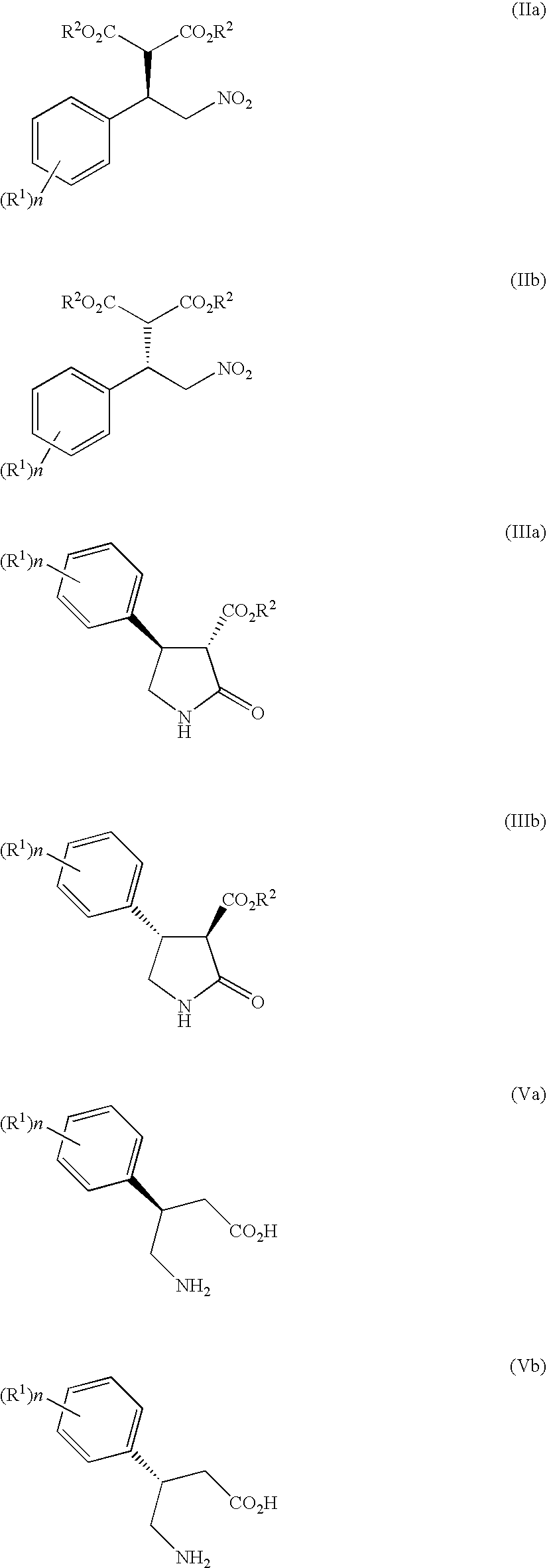Method of producing optically active 4-amino-3-substituted phenylbutanoic acid
a technology of phenylbutanoic acid and phenylbutanoic acid, which is applied in the direction of organic chemistry methods, chemistry apparatus and processes, organic chemistry, etc., can solve the problems of difficult control of carbon dioxide to be generated, non-applicable disturbance, and inability to achieve the effect of ensuring the effect of stability and reducing the number of occurrences
- Summary
- Abstract
- Description
- Claims
- Application Information
AI Technical Summary
Benefits of technology
Problems solved by technology
Method used
Image
Examples
example 1
Synthesis of dimethyl (R)-2-(1-(4-chlorophenyl)-2-nitroethyl)malonate
[0178]Under a nitrogen atmosphere, 4-chlorobenzaldehyde (2.5 g, 18 mmol) and ammonium acetate (2.5 g, 32 mmol) were dissolved in acetic acid (19 ml), and the solution was heated up to 90° C. Nitromethane (5.4 g, 89 mmol) was dropped at 90° C. over a period of 1 hour, and the mixture was stirred at the same temperature for 4 hours. The mixture was cooled to 50° C., and at the same temperature, water (19 ml) was dropped over a period of 1 hour, to deposit a coarse crystal of 4-chloro-β-nitrostyrene. After completion of dropping, the mixture was stirred at room temperature for 1 hour, further cooled to 10° C., and stirred at the same temperature for 1 hour, then, a crystal was filtrated and washed with water (19 ml) to obtain 4.32 g of a hydrated coarse crystal of 4-chloro-β-nitrostyrene (water amount: 1.7 g (water content: 40%), 4-chloro-β-nitrostyrene content: 2.61 g).
[0179]This hydrated coarse crystal of 4-chloro-β...
example 2
Synthesis of methyl (3S,4R)-4-(4-chlorophenyl)-2-oxopyrrolidine-3-carboxylate
[0180]To 210 ml of methanol was added 42.0 g (133 mmol) of dimethyl (R)-2-(1-(4-chlorophenyl)-2-nitroethyl)malonate and developed nickel (21 g), and the mixture was reacted at 35° C. for 8 hours under a hydrogen pressure of 0.5 Mpa (gauge pressure). After completion of the reaction, the nickel catalyst was filtrated, and the filtrate was concentrated under reduced pressure. Ethyl acetate and water were added to cause liquid-separation, the organic layer was concentrate under reduced pressure, and crystallized from heptanes / ethyl acetate. The resultant crystal was filtrated, and dried under reduced pressure, to obtain 28.8 g (114 mmol) of a title compound.
Yield: 85%. mp 166° C.
[0181]1H NMR (CDCl3, 400 MHz) δ 7.34-7.31 (2H, m), 7.22-7.18 (2H, m), 4.09 (1H, dd, J=8.0 Hz, 8.4 Hz), 3.84-3.81 (1H, m), 3.79 (3H, s), 3.54 (1H, d, J=10.0 Hz), 3.40 (1H, dd, J=8.0 Hz, 8.4 Hz) 13C NMR (CDCl3, 100 MHz) δ 172.3, 169.2, 1...
example 3
Synthesis of (R)-4-(4-chlorophenyl)pyrrolidin-2-one
[0183]Under a nitrogen atmosphere, to methanol (220 ml) was added methyl (3S,4R)-4-(4-chlorophenyl)-2-oxopyrrolidine-3-carboxylate (28.0 g, 110 mmol), and 2 mol / L sodium hydroxide aqueous solution (66 ml) was dropped over a period of 1 hour. After completion of dropping, the mixture was further stirred for 1 hour, and neutralized with 2 mol / L hydrochloric acid (71 ml), and methanol was distilled off under reduced pressure. The residue was extracted with ethyl acetate (150 ml×2), to obtain an ethyl acetate solution containing (3S,4R)-4-(4-chlorophenyl)-2-oxopyrrolidine-3-carboxylic acid. This solution was dropped over a period of 4 hours into xylene (150 ml) heated at 130 to 140° C. while distilling off ethyl acetate. After completion of the reaction, xylene (100 ml) was added, and the mixture was filtrated and concentrated under reduced pressure. Crystallization from xylene / heptanes was performed to obtain 19.3 g (98.6 mmol) of a ti...
PUM
| Property | Measurement | Unit |
|---|---|---|
| temperature | aaaaa | aaaaa |
| temperature | aaaaa | aaaaa |
| temperature | aaaaa | aaaaa |
Abstract
Description
Claims
Application Information
 Login to View More
Login to View More - R&D
- Intellectual Property
- Life Sciences
- Materials
- Tech Scout
- Unparalleled Data Quality
- Higher Quality Content
- 60% Fewer Hallucinations
Browse by: Latest US Patents, China's latest patents, Technical Efficacy Thesaurus, Application Domain, Technology Topic, Popular Technical Reports.
© 2025 PatSnap. All rights reserved.Legal|Privacy policy|Modern Slavery Act Transparency Statement|Sitemap|About US| Contact US: help@patsnap.com



